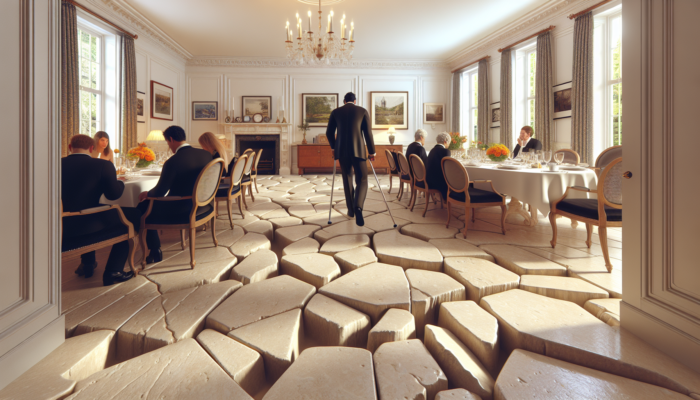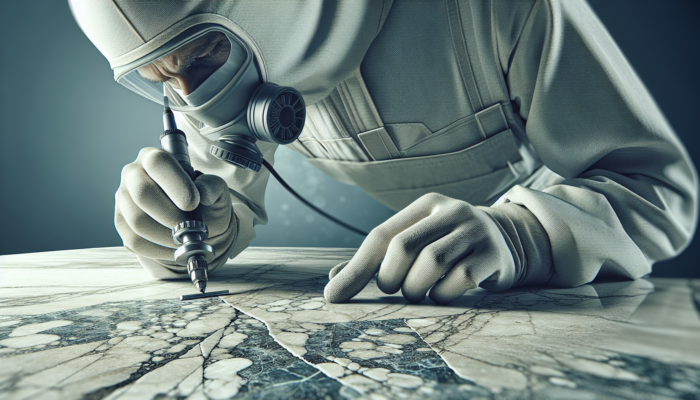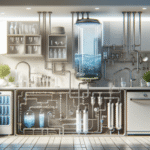Professional Strategies for Successfully Eliminating Limestone Lippage
Limestone flooring adds a touch of sophistication to any environment; however, the presence of uneven tiles, commonly referred to as lippage, can significantly detract from its beauty and pose safety risks. This comprehensive guide offers an in-depth examination of the various factors leading to lippage, outlines professional techniques for its removal, and introduces DIY strategies aimed at restoring a smooth and polished finish. Whether you're dealing with minor surface imperfections or contemplating hiring experts, the solutions presented here will help achieve a perfect limestone surface that satisfies both aesthetic desires and functional requirements.
In-Depth Exploration of Lippage Issues in Limestone Flooring: Causes and Solutions
Decoding Lippage: Understanding the Problem of Uneven Limestone Tiles

Lippage arises when the edges of adjacent <a href="https://limitsofstrategy.com/sealers-for-limestone-floors-essential-tips-for-uk-homeowners/">limestone tiles</a> fail to align properly, creating an uneven surface that poses significant tripping hazards. Picture hosting a dinner gathering where your guests must navigate around irregular bumps in the flooring instead of relishing the atmosphere. This not only undermines the aesthetic appeal of your space but also leads to frustration and potential safety concerns. In the UK, celebrated for its rich architectural legacy, the stark presence of lippage starkly contrasts with the traditional elegance expected in both residential and public buildings.
The visibility of lippage becomes particularly pronounced in areas with high foot traffic, where the flooring endures constant wear. Each misaligned tile disrupts the natural flow of movement, transforming a cosmetic issue into a pressing safety concern. Recognising and comprehending lippage is a vital initial step in preserving your limestone surfaces to ensure they remain not only visually appealing but also safe and functional throughout their lifespan.
Uncovering the Primary Factors Contributing to Lippage in Limestone Flooring
A plethora of factors contributes to the emergence of limestone lippage. The most significant cause is inadequate installation. If the underlying subfloor is not level, the limestone tiles will inevitably mirror these imperfections, leading to frustrating height discrepancies. Imagine a contractor rushing through the installation process, neglecting the essential leveling steps, leaving you with a flooring dilemma that is both challenging and expensive to rectify.
Additionally, natural elements exert a profound influence on the development of lippage. As a sedimentary rock, limestone is susceptible to expansion and contraction due to fluctuations in temperature, moisture, and humidity. In the UK, where weather conditions can often be unpredictable, these natural movements can exacerbate lippage problems over time, leading to increased repair costs and concerns for homeowners.
Furthermore, the age of the limestone plays a critical role in lippage complications. Over time, natural wear can create additional gaps and height discrepancies that jeopardise the integrity of the flooring. Understanding the myriad causes of lippage is vital for homeowners and property managers, particularly in historic buildings where the preservation of limestone flooring is essential for maintaining its character and safety.
Assessing the Visual and Safety Implications of Lippage
The visual appeal of limestone is undeniable, as it introduces an element of elegance and sophistication to any setting. However, the presence of lippage can drastically diminish this charm. A beautifully crafted limestone floor can quickly devolve into a visual distraction, as uneven tiles disrupt the overall aesthetic coherence of the space.
In high-traffic areas, even a single misstep can lead to injury, elevating lippage from a mere aesthetic concern to a significant safety issue. Whether in a bustling café or a historic landmark, ensuring a smooth surface is paramount for both visual appeal and safety. This detailed guide examines the causes of lippage, along with professional removal methods and DIY techniques aimed at restoring a flawless finish, helping homeowners and business proprietors prioritise a secure and polished environment.
Effective Techniques for Successfully Addressing and Eliminating Lippage from Limestone Surfaces

Grinding and Honing: The Premier Technique for Effective Lippage Removal
The methods of grinding and honing are widely recognised as the most effective solutions for addressing limestone lippage. This approach utilises diamond abrasives to level the high edges of limestone tiles, resulting in a smooth, flush surface that feels luxurious underfoot. Consider this process akin to providing your flooring with a lavish spa treatment that eliminates unsightly height discrepancies and reinstates visual harmony throughout your living area.
The grinding and honing process typically involves a series of grinding pads, each with varying grit levels. The procedure begins with a coarse pad designed to remove high spots, gradually transitioning to finer pads to achieve a polished finish. The transformation is striking; those previously uneven tiles evolve into a seamless expanse of limestone beauty, enhancing the sophistication of any environment.
For homeowners in the UK, investing in this technique not only elevates aesthetics but also promotes durability. A smooth surface minimises wear and tear, thereby extending the lifespan of your flooring. This method is particularly crucial in commercial settings, especially in high-traffic areas where durability is of utmost importance. While the initial cost may seem considerable, the long-term benefits make it a clear choice for anyone serious about maintaining their limestone surfaces.
Mechanical Planing: Achieving Precision in Lippage Removal Techniques
If precision is your goal when it comes to lippage removal, mechanical planing is the technique to consider. This method employs specialised tools designed to shave down high spots on limestone tiles, ensuring a perfectly level surface. Visualise it as trimming away imperfections to reveal a sleek and smooth finish that elevates the overall aesthetic of the flooring.
Mechanical planing is particularly beneficial for larger areas or commercial properties where efficiency is paramount. The method involves a machine equipped with diamond tools that gently and accurately remove high edges from tiles without disturbing the surrounding material. This equipment reduces downtime, allowing for a quicker return to full functionality for business owners—especially critical in the fast-paced environments typical of daily operations.
Homeowners can also benefit from mechanical planing as an excellent solution for stubborn lippage issues, particularly when traditional methods may prove inadequate. Ensuring your limestone surfaces are level in a country rich in historic architecture and contemporary homes can significantly enhance both the aesthetic appeal and safety of your environment.
Crucial Tools and Equipment for Successful Lippage Removal
The Essential Role of Diamond Abrasives in Lippage Removal
When it comes to effectively addressing lippage, diamond abrasives are invaluable allies. These exceptionally durable materials are critical for grinding and honing limestone surfaces, enabling the elimination of lippage. Consider them the powerhouses in your flooring restoration toolkit; they are indispensable for anyone serious about achieving a flawless finish on their limestone surfaces.
Diamond abrasives are available in various grits, allowing for a customised approach to lippage removal. Starting with a coarser grit to tackle high points and progressing towards finer grits ensures a smooth surface that gleams beautifully. The results are striking—a stunning surface that not only looks exquisite but also feels luxurious underfoot, enhancing the overall experience of any space.
For professionals operating in the UK, investing in high-quality diamond abrasives can significantly enhance their efficiency and effectiveness when dealing with lippage. Furthermore, these tools can be utilised across various projects, making them a versatile addition to any toolkit dedicated to flooring restoration.
Maximising Efficiency with Specialized Lippage Removal Machines
In the realm of flooring restoration, time is of the essence. This is where specialised lippage removal machines come into play. Designed to expedite the process while delivering consistent results, these machines act as the unsung heroes in the battle against lippage.
Equipped with diamond pads, lippage removal machines swiftly grind down high spots, making them ideal for expansive areas or commercial properties where efficiency is critical. Picture a bustling café in Manchester, where patrons expect nothing less than perfection—having a reliable machine at your disposal allows you to maintain immaculate floors without disrupting business operations.
For homeowners, investing in or renting such equipment can save both time and effort when addressing lippage issues. Whether you consider yourself a DIY enthusiast or a seasoned professional, access to lippage removal machines can transform your flooring projects from daunting tasks into manageable undertakings.
Prioritising Safety Gear During the Lippage Removal Process
Safety should always be the top priority! Wearing protective gear is essential when working with limestone and power tools. Essential equipment includes gloves, goggles, and dust masks to shield yourself from the dust and debris generated during dry lippage removal. Attempting a lippage project without appropriate safety gear is a surefire way to escalate a straightforward task into a trip to the emergency room.
Gloves protect hands from sharp edges or accidental slips, while goggles safeguard eyes from flying particles. Dust masks are crucial when grinding or shaving limestone, as inhalation of dust can pose serious health risks. For homeowners in the UK, prioritising safety during the restoration of limestone surfaces is just as vital as the restoration process itself.
Investing in high-quality safety gear not only protects you but also imparts a professional appearance to your work. Whether you are a DIY enthusiast or an experienced contractor, prioritising safety ensures that your lippage removal project proceeds smoothly and without incident.
Evaluating the Advantages and Disadvantages of Professional Services Versus DIY Approaches for Lippage Removal
The Benefits of Engaging Professional Lippage Removal Services
Hiring professional services for lippage elimination guarantees expert precision, enduring quality, and invaluable peace of mind. Equipped with the right tools and extensive experience, they handle everything from minor unevenness to substantial height discrepancies, achieving results that DIY attempts often struggle to replicate. Beyond delivering a flawless finish, they provide essential maintenance guidance, ensuring the longevity of limestone surfaces for years to come. Professional care enhances safety and value in the UK, where aesthetic considerations are paramount—especially in historic properties.
Essential DIY Tips for Successful Lippage Removal
For those with a spirit of adventure, embarking on DIY lippage removal can be a rewarding challenge. However, it is crucial to approach this task armed with the right knowledge and techniques. Start with small projects, concentrating on minor lippage issues using a hand grinder. This method allows you to familiarise yourself with the process without diving headfirst into a more complex project that could lead to further complications.
Always ensure that you have the appropriate safety gear before commencing any work. A dust mask is essential when grinding limestone, as the dust can be harmful if inhaled. Additionally, practice patience; ensure that each tile is ground down evenly. Rushing the process can exacerbate the issue rather than resolve it.
While DIY remains a viable option for minor lippage issues, it is crucial to recognise your limits. If you encounter extensive problems or feel uncertain about your capabilities, seeking the assistance of professionals is a wise investment. They can swiftly address larger issues, ensuring that your limestone surfaces remain both stunning and safe for all who enter your space.
Recognising When to Seek Professional Assistance for Lippage Problems
Some situations necessitate the expertise of a professional. If you encounter severe lippage—especially in expansive areas or where safety is a concern—it is time to enlist the experts. Recognising when a job exceeds your capabilities is not a sign of weakness; it is a prudent decision, as professionals are trained to handle such challenges effectively.
If you notice that tiles are cracking or if there are signs of water damage accompanying the lippage, it is essential to address these concerns promptly. Ignoring such issues can lead to more significant complications down the line. Professionals can assess the situation, identify the root causes, and implement effective strategies to mitigate the problem.
Investing in professional lippage removal services can save homeowners and business proprietors time, reduce stress, and ultimately prove cost-effective in the long haul. With the right team by your side, you can ensure that your limestone surfaces are not only visually appealing but also safe and functional, preserving the beauty of your space for years to come.
Strategic Maintenance Approaches for Extending the Life of Limestone Surfaces
Establishing a Routine for Cleaning and Sealing Limestone Flooring
Once lippage has been effectively addressed, it is crucial to establish a maintenance routine that includes regular cleaning and sealing. Limestone is a porous material that can absorb spills and stains if not properly maintained. A thorough cleaning regimen helps to preserve the fresh appearance of your floors while protecting them from potential future lippage issues.
Begin by sweeping or vacuuming to eliminate dirt and debris, followed by mopping with a pH-neutral cleaner specifically formulated for limestone. Avoid using acidic or abrasive chemicals, as these can damage the stone surface. After cleaning, it is essential to regularly seal the limestone to safeguard against moisture and wear, significantly reducing the likelihood of lippage re-emerging.
Sealing is particularly vital in the UK, where weather conditions can vary dramatically. It acts as a protective barrier against moisture penetration, which can lead to expansion and contraction, both of which contribute to lippage. A well-maintained floor plays a crucial role in preserving the beauty and integrity of your limestone surfaces over the long term.
Proactive Monitoring for New Signs of Lippage Development
Another important aspect of maintaining your floors is actively monitoring them for signs of new lippage; vigilance regarding your surfaces is essential. Regular inspections can help identify potential issues before they escalate, saving you both time and money.
Look for any signs of unevenness, cracks, or changes in the appearance of your tiles. Should you observe lippage beginning to develop again, addressing it promptly can prevent it from becoming a more significant concern. Simple measures, such as adding felt pads to the bottoms of heavy objects, can help minimise wear and tear on your flooring.
Monitoring is especially critical in historical buildings. A proactive approach in historic or commercial properties where foot traffic is prevalent not only enhances safety but also ensures that your flooring remains a beautiful focal point, positively contributing to the overall atmosphere of your space.
Strategies for Prolonging the Life of Your Limestone Surfaces
To extend the lifespan of your limestone flooring, consider adopting some straightforward yet effective habits. First, avoid dragging heavy objects across the floor, as this can exacerbate lippage issues and cause scratches. Instead, lift and place heavy items to alleviate unnecessary stress on your tiles.
Another effective strategy is to utilise area rugs in high-traffic zones to absorb some of the wear and tear that can contribute to lippage while also providing an opportunity to showcase decorative elements in your home or business.
Routine maintenance, including periodic cleaning and sealing, is vital for keeping surfaces pristine. By implementing a few minor changes, you can significantly extend the life of your limestone, ensuring it remains a striking feature of your property for many years.
The Importance of Professional Inspections and Ongoing Maintenance for Limestone Surfaces
Scheduling regular professional inspections and maintenance for your limestone surfaces can greatly enhance their longevity and appearance. Experts can identify potential issues before they escalate into serious problems, ensuring that your floors remain safe and stylish.
Consider establishing a maintenance plan with a local flooring specialist who can perform regular assessments and cleanings. In a country like the UK, where limestone is prominently featured in both historic and modern architecture, ensuring that these vital surfaces are well-maintained is essential for preserving their beauty and functionality over time.
Professional care not only ensures the aesthetic appeal of your limestone but also provides peace of mind. You can enjoy your floors without the anxiety of hidden issues, allowing you to focus on what truly matters—creating a welcoming and beautiful environment for all who enter your space.
Inspirational Case Studies and Success Stories in Efficient Lippage Removal
Transforming Residential Limestone Flooring: A Remarkable Restoration
A notable case study features a charming Victorian house in Oxford that faced significant lippage issues, detracting from the beauty of their limestone flooring and creating safety concerns for their young children. After conducting thorough research into various options, the homeowners decided to invest in professional lippage removal services.
The restoration team employed grinding and honing techniques, effectively restoring the original floors to their former glory. The transformation was extraordinary; what was once a source of anxiety became a beautifully level surface that dramatically enhanced the interior of the home. Additionally, safety concerns were alleviated, allowing the family to enjoy their space with peace of mind.
This success story underlines the importance of promptly addressing lippage issues and highlights the effectiveness of professional intervention. The homeowners were thrilled with the results, adding value to their property and enjoying the tranquillity that comes with a safe and aesthetically pleasing living environment.
Successful Applications of Lippage Removal in Commercial Settings
In a busy café located in London, uneven tile edges had become an increasingly urgent concern. The uneven flooring not only compromised the café’s aesthetics but also posed hazards for customers and staff. Recognising the need to address the issue, the owner opted for professional lippage removal services.
Through careful shaving of high spots, the team restored a level surface, resulting in a sleek and inviting environment that enhanced the customer experience and mitigated potential liabilities. The café transformed its entrance into a space where patrons could feel comfortable while enjoying their meals.
This case exemplifies the crucial intersection of aesthetics and functionality in commercial settings. Successful lippage removal elevated the café’s atmosphere, ultimately contributing to its success in a competitive market.
Restoration of Historical Limestone Features: A Case Study of Success
A historic building in Bath, renowned for its stunning architecture and rich heritage, faced a severe lippage problem that threatened its original limestone features. The management team understood the importance of preserving the building’s physical integrity while enhancing visitor safety, prompting them to hire a professional restoration service specialising in historical limestone preservation. The team effectively eliminated lippage while maintaining the stone’s authenticity through grinding and careful chemical treatments. The outcome was breathtaking, as the limestone features were restored to their original splendour, improving safety throughout the building.
This case study serves as a powerful reminder of how professional lippage removal can elegantly merge preservation with practicality. The building retained its historical significance while becoming a safer space for visitors, showcasing the beauty and durability of limestone.
Frequently Asked Questions (FAQs) Regarding Lippage Removal Techniques
What is involved in the limestone lippage removal process?
The limestone lippage removal process encompasses various techniques aimed at rectifying uneven edges between adjacent limestone tiles, ensuring a flat, safe surface that eliminates tripping hazards.
How can I prevent lippage from occurring in my limestone flooring?
Regular maintenance, proper installation, and vigilant monitoring for moisture can significantly help prevent lippage. Additionally, sealing your limestone reduces the risk of expansion and contraction, contributing to its longevity.
Is it possible for me to tackle lippage removal myself?
While minor lippage can be addressed using DIY methods like grinding, severe lippage issues should be left to professionals to ensure the application of proper techniques and maintain safety.
What are the common indicators of lippage in limestone tiles?
Indicators of lippage include visible height differences between tiles, cracks, or uneven surfaces, all of which can lead to potential tripping hazards.
How frequently should I clean and seal my limestone floors?
It is advisable to clean limestone floors regularly and seal them every 6 to 12 months, depending on factors such as foot traffic and overall wear.
What tools do I require for DIY lippage removal?
Essential tools for DIY removal include a hand grinder, diamond abrasives, safety gear, and a pH-neutral cleaner for ongoing maintenance.
Is lippage removal an expensive undertaking?
The cost of lippage removal varies based on the severity of the issue and the size of the affected area; however, investing in quality services can yield long-term savings.
Can lippage reappear after removal?
Lippage can re-emerge if the underlying causes, such as improper installation or moisture issues, are not addressed properly.
What is the most effective method for addressing severe lippage?
Professional techniques such as grinding, chemical treatments, or mechanical planing are the most effective methods for restoring a level surface after severe lippage.
How long does the lippage removal process typically take?
The time required for the lippage removal process depends on the size of the area and the techniques employed; professionals can usually complete it within a few hours to a few days.
The post Professional Strategies for Successfully Eliminating Limestone Lippage appeared first on https://tilecleaningsurrey.co.uk
The Article Limestone Lippage Removal Solutions That Work appeared first on https://fabritec.org
The Article Limestone Lippage Removal: Effective Solutions That Work Was Found On https://limitsofstrategy.com

